Kitchen GFCI Receptacle Requirements, Locations & Other Electrical Tips
If you have an older kitchen, and for any reason decided to replace a regular electrical outlet - you should have a GFCI receptacle installed as a replacement.
Kitchen GFCI receptacles are required by the 2008 NEC (National Electrical Code) to be installed along the countertop surfaces.
- GFCI – (Ground Fault Circuit Interrupter)
Actually, this requirement has been in place since 1996 NEC, and an important thing to remember:
If you have an older kitchen, and for any reason decided to replace a regular electrical outlet – you should have a GFCI receptacle installed as a replacement.
Kitchen Electrical Requirements
- Kitchen electrical outlets installed above the countertops require at least 2 small appliance branch circuits.
- Kitchen electrical circuits serving countertop outlets must be rated for 20 ampers (#12 wire)
- Kitchen GFCI receptacles installed on those 20 amp circuits must be also 20 amp rated
Example: for 5 kitchen GFCI receptacles serving countertops there should be a minimum of 2 circuit breakers (or two fuses) in your electrical panel – one protecting 3 of those outlets, and second responsible for other 2 (or 4 & 1 – it doesn’t matter).
Those two or more electrical circuits supplying power to the kitchen GFCI receptacles (above the countertop) must also serve remaining kitchen open walls, pantry and dinning room receptacles.
However, they can not be used for the kitchen lighting or outlets located within the cabinets or cupboards (sometimes used to for a under the cabinet lights low voltage transformer or regular voltage light fixtures, microwave or other permanently installed appliances). GFCI protection is not required for those extra receptacles, but since installed on a 20 amp rated circuits, they must be also 20 amp rated.
There are two exceptions; the two (or more) electrical circuits providing power to the kitchen GFCI receptacles can be also used to:
- support operation of an electric clock
- provide power to supplemental equipment and lighting on gas ranges, ovens or cook-tops (electronic display, control panels, etc.)
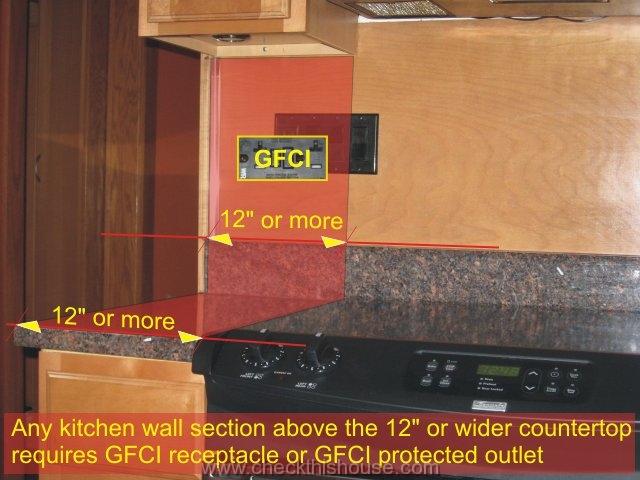
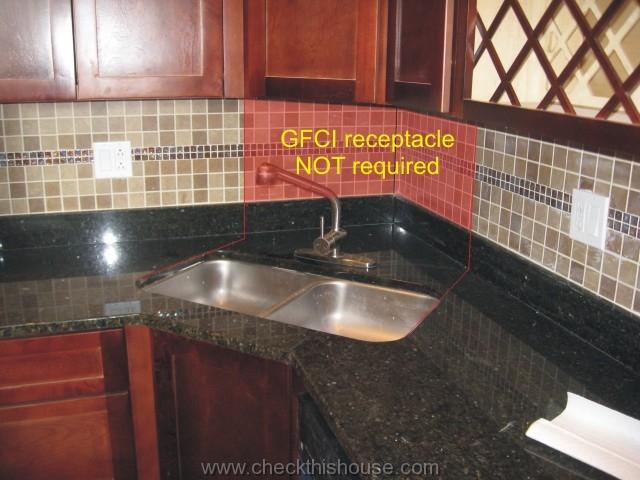 Number of required kitchen GFCI protected receptacles above the countertop – it all depends on how long is your countertop…
Number of required kitchen GFCI protected receptacles above the countertop – it all depends on how long is your countertop…
- Every 12″ wide section of the kitchen wall countertop space requires a GFCI protected receptacle
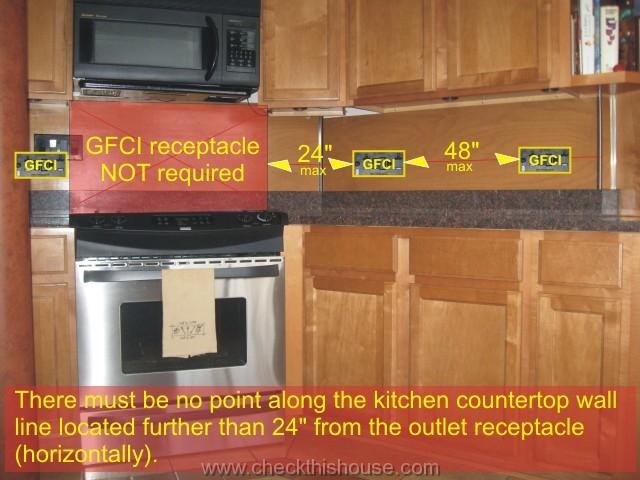
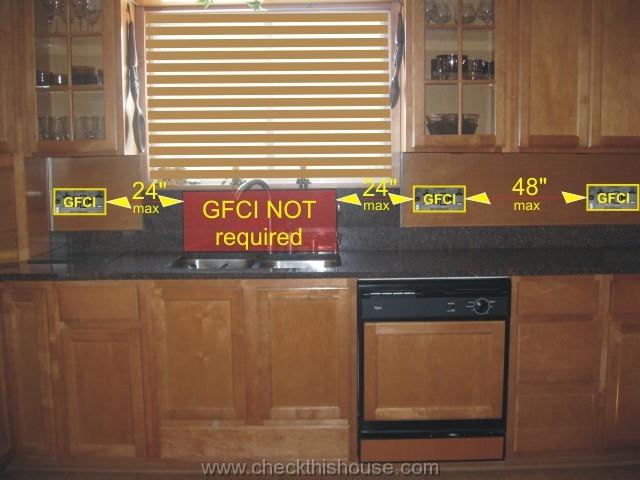
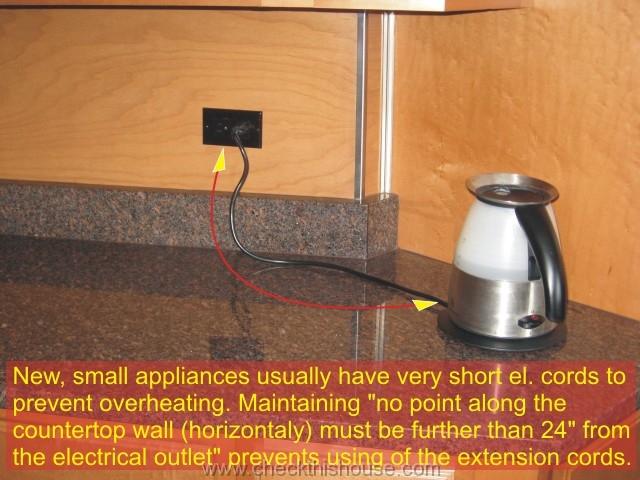 There must be no point along the kitchen countertop wall line located further than 24″ from the GFCI outlet receptacle (horizontally). Most of the new appliances are equipped with very short electrical cords to prevent them from overheating, tangling, etc.
There must be no point along the kitchen countertop wall line located further than 24″ from the GFCI outlet receptacle (horizontally). Most of the new appliances are equipped with very short electrical cords to prevent them from overheating, tangling, etc.
Because of those short appliance cords, electrical outlets spacing should be maintained so close. However, no electrical outlets are required on the wall directly above the kitchen range, cook-top or sink.
Kitchen refrigerator power supply does not require GFCI protection, just an individual (15amp rating or more) branch circuit (if you have a refrigerator in the garage or an unfinished basement, 2008 NEC decided to put it on a GFCI protected circuit).
You can use one of the two small appliance GFCI protected circuits, but an individual circuit makes more sense for this purpose.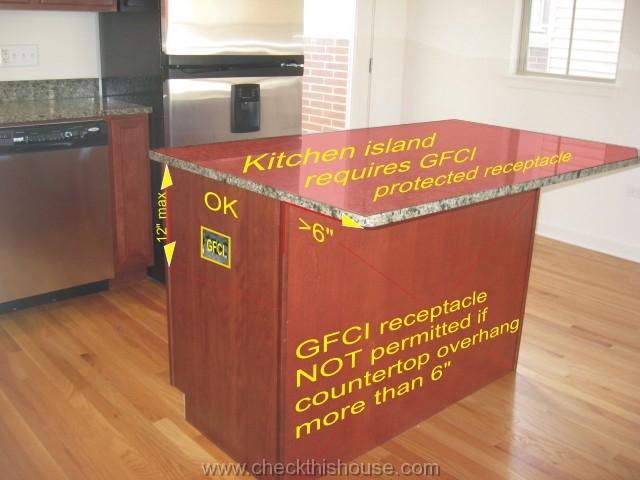 Kitchen GFCI requirement also applies to an island and peninsula countertop – if it has a minimum dimensions of 12″ x 24″ it requires at least one GFCI protected electrical outlet. In case you have a larger island (or any) countertop, divided by the sink, or a cook-top, range, etc., and there is less than 12″ of counter-space behind that dividing sink or appliance – each of the sections would require a GFCI protected receptacle.
Kitchen GFCI requirement also applies to an island and peninsula countertop – if it has a minimum dimensions of 12″ x 24″ it requires at least one GFCI protected electrical outlet. In case you have a larger island (or any) countertop, divided by the sink, or a cook-top, range, etc., and there is less than 12″ of counter-space behind that dividing sink or appliance – each of the sections would require a GFCI protected receptacle.
Kitchen GFCI outlet locations above and below the countertops
- Not more than 20″ above
- Not more than 12″ below (island and peninsula with no backsplashes, dividers, etc.) if the countertop overhang is 6″ or smaller. Those side wall receptacles create a safety hazard for children reaching them or anyone accidentally brushing the hanging cord, but often this is the only choice. I would highly recommend to use that kitchen GFCI protected receptacle under supervision (if you have small children), and remove the plug as soon as you’re finished.
Garbage disposer, dishwasher, microwave do not require GFCI protection, and can not be supplied by the small appliance circuits. Depending on the amount of power they need (check the nameplate or installation instructions), you can either use 1, 2 or 3 circuits (if nothing else will be on those electrical circuits).
Below are typical ratings of those appliances – they should not use more than 80% of the circuit breaker rating protecting it if on dedicated circuit, or 50% if sharing the circuit with something else:
- 1/2 HP garbage disposal – 2.5 amp (WasteMade garbage disposer)
- dishwasher – 9 to 12 amp
- microwave – 4.5 to 12 amp
Example: small microwave + garbage disposer = 6 amp + 2 amp = 8 amp – you can install both of them on a single, dedicated circuit protected by a 20 amp breaker because they will use less than 50% of the breakers’ rating (15 amp breaker would be too small)
No face-up kitchen GFCI receptacles (and no unprotected devices of course) are permitted!



Comments are closed.